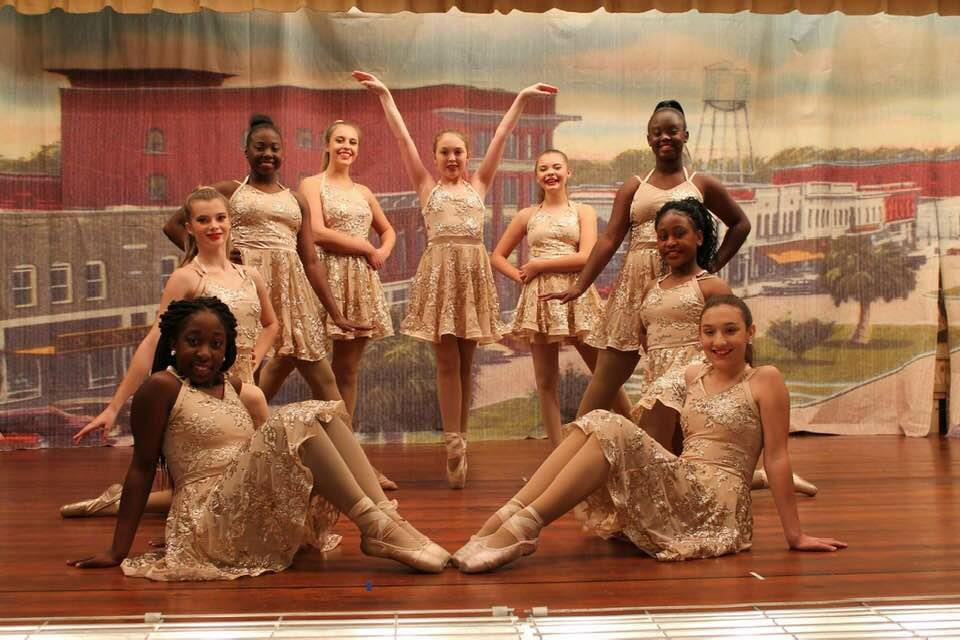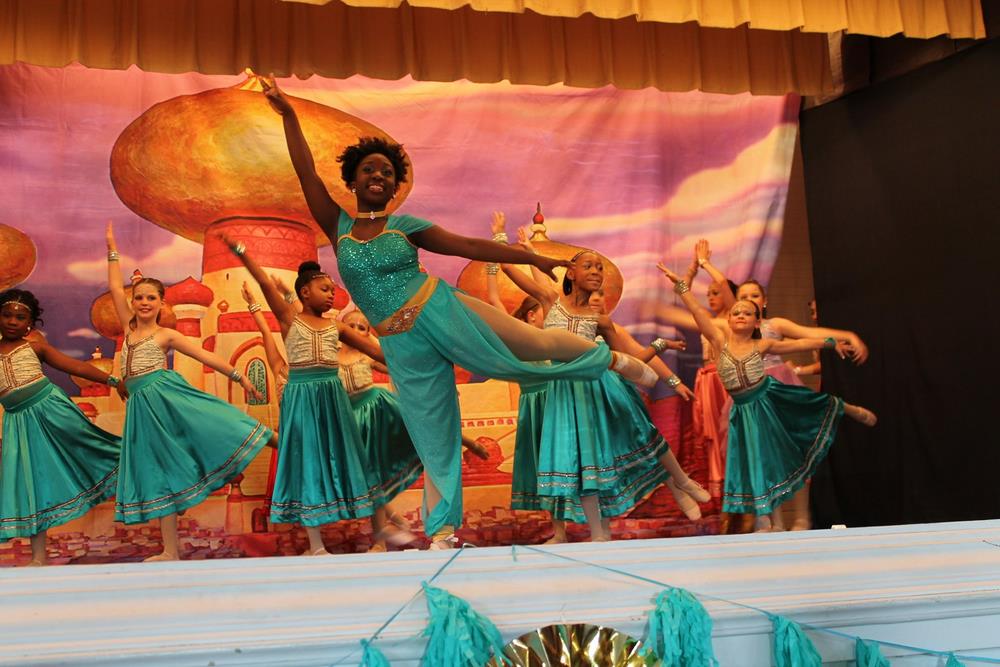NDEO’s Guest Blog Series features posts written by our members about their experiences in the fields of dance and dance education. We continue this series with a contribution by Lindsay Herring, Director of Middle and High School Fine Arts and Dance Instructor at Brooks County High School. Guest posts reflect the experiences, opinions, and viewpoints of the author and are printed here with their permission. NDEO does not endorse any business, product, or service mentioned in guest blog posts. If you are interested in learning more about the guest blogger program or submitting an article for consideration, please visit this link.
Working Backwards: A Choreographic Process
By Lindsay Herring, Director of Middle and High School Fine Arts/Dance Instructor, Brooks County High School

Like many other dance educators nationwide, I find myself teaching a unit on choreography to intermediate and advanced dancers each year. These dancers are mastering their craft and honing their skills in real ways, yet I find myself wondering: Are they utilizing their emotions and creativity to start the process? Are these students, new to the craft of choreography, actually using their own thoughts and feelings to create their masterpieces, or are they “working backwards” - borrowing emotion from others by hearing and feeling the music first, and matching movements to what they interpret?
As a student of the arts, I was blessed with the ability to act and emote through my face - an especially useful trait for “selling” a dance on stage. Though my dance performance skills benefited from that love of and training in theatre, I struggled with “bad” feet, poor technique, and countless other shortcomings which I was often reminded of at the barre. Stubbornness kept me pushing and practicing dance, and I found myself choreographing my first pieces at a relatively young age. Like the dancers I now teach, I would hear a song which elicited some emotion and begin to jot down eight counts to match that which I perceived were my genuine emotions. While these feelings might have mirrored those of my own, I wasn’t challenging myself enough to uncover my true responses to the world around or inside of me.
Fortunately for my younger self (and my older self), I was blessed with a myriad of amazing teachers, choreographers, and professors throughout my learning who taught me the importance of what I now refer to as dance what you know. My teachers taught me that engaging in some type of ritualistic activity, be that a reflective walk, journaling, meditation, sketching, or just taking a few minutes from your day or week to allow your mind to rest and inspiration to enter, is key to the choreographer’s practice. By using these activities to find my inspiration first, I was able to explore movements in a more authentic way and my dances were able to connect with both my performers and audiences to unimaginable outcomes.
As an educator, however, I found helping students reach a place where they are able to explore authentic feelings to be a much more difficult task, even after introducing them to the rituals that help me find creative inspiration. Over time, I found that when I link dance choreography projects more closely with citizenship and current events (whether global or specific to their own lives), students are much more likely to respond in genuine ways. I begin this process by asking students what concerns them the most, and we discuss what is happening in our world and how they can use dance or other forms of artistic expression to understand or react to the feelings that might arise from those events. Next, we look at their own personal lives, political feelings, or familiar stories and how dance might be used to explore these facets of their lives. And finally, we explore stories relative to our own community which highlight persons they can relate to: historical or contemporary figures who accomplished great things or possibly even experienced tremendous heartache.
After the students have selected a broad topic, we briefly discuss the life and times of William Shakespeare and his sonnets, paying particular attention to Sonnet 18 with which most of the students are familiar: “Shall I compare thee to a summer's day?” and the students and I dissect the rhyme scheme and volta, as well as the vivid language. This year, to further the conversation into Social Justice Education and Action, the students and I researched the poet Claude McKay and his work, If We Must Die, a Shakespearean Sonnet written during the Harlem Renaissance which challenged African Americans to bravely resist their oppressors even in the face of violence. Once the research and discussions are completed, students begin taking their broad topics and translating them into fourteen line sonnets of their own. Placing their own feelings into written words tends to be cathartic, and allows the students to cultivate their feelings first which we present to the class through a series of peer reviews and group reading and revising sessions.
Once the sonnets are created, each student is given the choreographing worksheets I utilize in my courses which are broken down into Inspiration, Exploration, and Expression. During Inspiration, dancers are challenged to try finding their own inspiration through their own idea, experience, and feeling, or by responding to culture, writing, or everyday life. In this activity, the dancers found their inspiration through the creation of their own sonnet. During this phase each will answer reflexive and perspective questions about their sonnet, such as: How do I feel? What may this inspiration mean to others? The students’ inspiration should lead them to choosing the music for their self-choreographed dances. For this assignment, I had each prepare a 60-second solo to really keep the process as close to home as possible. Next comes the Exploration phase where the students plan or assess their dances by making cursory decisions regarding the Who/Body, What/Action, Where/Space, When/Time, How/Energy, and Why/Relationship. During the final phase, Expression, students plan and present their solos followed by a period of creating and responding by answering the following questions: How do I feel now? What changes still need to be made? Is my message clear? How did my movements convey my message?

I believe students work backwards, finding their song first and creating movements to match borrowed or matched emotion, because they are just beginning to step into the unfamiliar world of choreography. An unintentional consequence of the nervousness of putting yourself out there for possibly the first time, working backwards is sometimes easier for young choreographers. I have found when I encourage students to centralize their emotions first, then choose their music and create choreography, students are more likely to experience a true sense of catharsis.
There are hundreds of ways to have your students self-choreograph a routine, but by introducing a system in which they must present their complete inspirational intention start-to-finish first, you are effectively creating a “choreographic problem.” You are challenging young minds to go a step beyond creating eight counts to where they are actually creating emotionally connective art.
Pro Tip: I have found that asking for help from your English Department is a wonderful way to open cross-curricular doors and sharing fun Shakespearean facts with your students will help to keep the discussion lively--did you know Shakespeare invented words like roadway, excitement, and dawn?!
 Devoted to performing and visual arts in rural South Georgia, Lindsay Herring combines her education in theatre and dance with her MBA to successfully own and operate SweetE's Dance Studio. Lindsay is now working on her second masters degree from Wayne State University and is also a full time employee of the Brooks County School System where she serves as the Middle and High School Fine Arts Director. Herring witnessed the power of the arts first hand with her initially non-verbal son, whose first sounds at nearly two and a half and were in response to musicals playing in the car. "Music and theatre were able to help assist in giving my boy a voice," she says. An award winning coach and choreographer, Herring has worked tirelessly through the shutdown to keep her doors open and help families who have difficulty paying still. "The balance has been hard, but we have kept pushing forward. The community has always supported me and the dancers, and I will never be able to thank them enough for all they've done my programs." Lindsay hopes to continue in Brooks County and watch her daughter and son thrive in the same loving arms that helped to raise her.
Devoted to performing and visual arts in rural South Georgia, Lindsay Herring combines her education in theatre and dance with her MBA to successfully own and operate SweetE's Dance Studio. Lindsay is now working on her second masters degree from Wayne State University and is also a full time employee of the Brooks County School System where she serves as the Middle and High School Fine Arts Director. Herring witnessed the power of the arts first hand with her initially non-verbal son, whose first sounds at nearly two and a half and were in response to musicals playing in the car. "Music and theatre were able to help assist in giving my boy a voice," she says. An award winning coach and choreographer, Herring has worked tirelessly through the shutdown to keep her doors open and help families who have difficulty paying still. "The balance has been hard, but we have kept pushing forward. The community has always supported me and the dancers, and I will never be able to thank them enough for all they've done my programs." Lindsay hopes to continue in Brooks County and watch her daughter and son thrive in the same loving arms that helped to raise her.